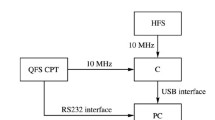The problem of developing a temperature compensation system in quantum frequency standards based on coherent population trapping is considered. The development of such a system significantly reduces the temperature coefficient of frequency (TCF), whose value is an order of magnitude higher than in rubidium frequency standards. One approach to reducing TCF is temperature compensation. The author proposes a temperature compensation method on the basis of the Zeeman effect for the shift of the actual frequency. A method for determining the minimum value of the magnetic field at which magnetically sensitive resonances have no impact on the reference resonance is considered. The performance of the quantum frequency standard both prior to and following the activation of the temperature compensation system is described.





Similar content being viewed by others
References
R. E. Hayes, T. J. Bennett, G. T. Norton, and M. M. Zepler, Electron. Lett., 6, No. 23, 734–735 (1970), https://doi.org/10.1049/el:19700509.
P. Rochat, B. Leuenberger, and X. Stehlin, in: Proc. 2002 IEEE Int. Frequency Control Symposium and PDA Exhibition, New Orleans, LA, USA (2002), pp. 451–454, https://doi.org/10.1109/FREQ.2002.1075924.
Y. Koyama, H. Matsuura, K. Atsumi, et al., in: Proc. 2000 IEEE/EIA Int. Frequency Control Symposium and Exhibition, Kansas City, MO, USA (2000), pp. 694–699, https://doi.org/10.1109/FREQ.2000.887439.
J. Hu et al., in: Proc. 2007 IEEE Int. Frequency Control Symposium Joint with the 21st European Frequency and Time Forum, Geneva (2007), pp. 599–601, https://doi.org/10.1109/FREQ.2007.4319142.
O. Kozlova, J. Danet, S. Guérandel, and E. de Clercq, IEEE T. Instrum. Meas., 63, No. 7, 1863–1870 (2014), https://doi.org/10.1109/TIM.2014.2298672.
S. A. Zibrov, V. L. Velichanskii, A. S. Zibrov, et al., “Experimental investigation of the dark pseudoresonance on the D1 line of the 87Rb atom excited by a linearly polarized field,” Pis’ma ZhETF, 82, No. 8, 534–538 (2005).
G. A. Kazakov, B. G. Matisov, I. E. Mazets, and Yu. V. Rozhdestvenskii, “Dark resonances in 87Rb atomic pairs during interaction with the field of codirected linearly polarized waves of different frequencies,” Zh. Tekh. Fiz., 76, No. 11, 20–29 (2006).
R. W. P. Drever, J. L. Hall, F. V. Kowalski, et al., Appl. Phys. B, 31, No. 2, 97–105 (1983), https://doi.org/10.1007/BF00702605.
W. Krzewick, J. Mitchell, J. Bollettiero, et al., in: Proc. 2020 Int. Technical Meeting of The Institute of Navigation, San Diego, California, Jan. 2020, pp. 1070–1083, https://doi.org/10.33012/2020.17198.
R. Lutwak, P. Vlitas, M. Varghese, et al., in: Proc. IFCS 2005, Vancouver, BC (2005), p. 6, https://doi.org/10.1109/FREQ.2005.1574029.
S. Knappe, V. Gerginov, P. D. D. Schwindt, et al., Opt. Lett., 30, No. 18, 2351–2353 (2005), https://doi.org/10.1364/OL.30.002351.
J. Zhao, R. Liu, H. Meng, et al., “Progress towards chip-scale atomic clock in Peking University,” in: EFTF/IFCS 2017, Besancon (2017), pp. 611–613, https://doi.org/10.1109/FCS.2017.8088973.
Author information
Authors and Affiliations
Corresponding author
Additional information
Translated from Izmeritel’naya Tekhnika, No. 6, pp. 8–12, June, 2021.
Rights and permissions
About this article
Cite this article
Paryohin, D.A. Temperature Compensation in Quantum Frequency Standards Based on Coherent Population Trapping. Meas Tech 64, 440–444 (2021). https://doi.org/10.1007/s11018-021-01952-y
Received:
Accepted:
Published:
Issue Date:
DOI: https://doi.org/10.1007/s11018-021-01952-y




